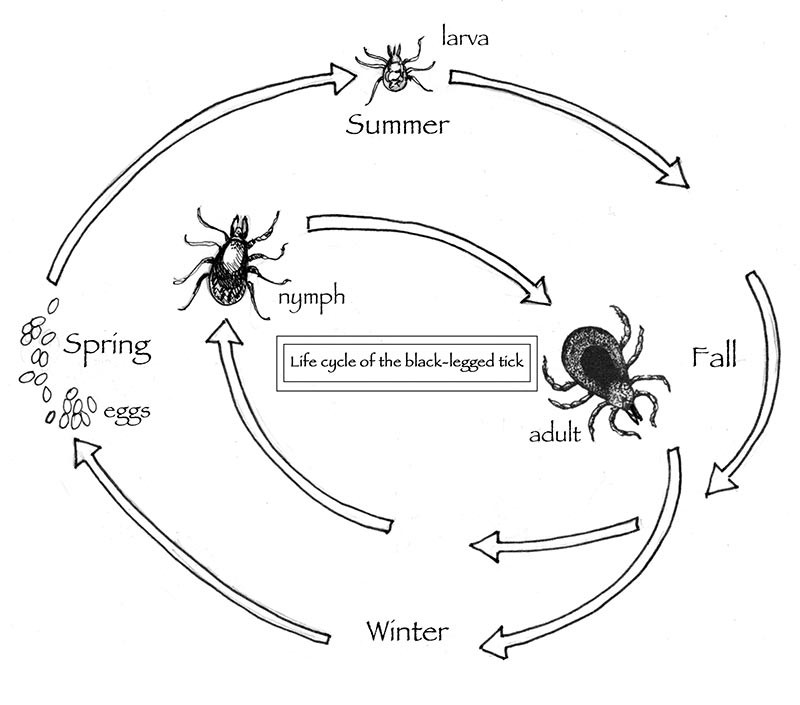
On a hike this spring, we walked through a clear-cut area with tall grass and brambles. Afterwards, our pant legs were crawling with black-legged ticks (Ixodes scapularis), also known as deer ticks, the kind that carry Lyme disease. Scientists with the Vermont Department of Health recently examined over 2,000 ticks and found that 53% of black-legged ticks tested positive for Lyme disease. A small percentage of the ticks carried pathogens that cause anaplasmosis or babesiosis, two other tick-borne diseases that can make people gravely ill.
Understanding the two-year life cycle of the black-legged tick can help prevent Lyme disease. In the spring of the first year, tick larvae hatch from honey-colored eggs in the leaf litter. The six-legged larvae, about the size of a poppy seed, soon seek their first blood meal. The larvae may become infected with the bacterium that causes Lyme disease through this blood meal; it all depends on what kind of animal they find as a host. If it’s a white-footed mouse, they’re very likely to contract the Lyme spirochete. If it’s a chipmunk or shrew, they’re somewhat likely. If it’s a squirrel or a larger mammal, they probably won’t.
After feeding, the larvae drop off into the leaf litter and remain dormant until the next spring. In the spring of year two, these larvae molt into eight-legged nymphs, the size of a pinhead, and seek another blood meal. While most feed on mice and chipmunks (and have another opportunity to contract Lyme disease), pets and humans may become unsuspecting hosts.
In late summer and fall, the adult ticks, now the size of an apple seed, attach to large mammals, usually deer, where they feed and mate. People and pets are susceptible to picking up ticks at this time, although at this stage they are easier to see and feel. After this last blood meal, the females lay up to 3,000 eggs and the two-year life cycle begins again.
Lyme disease was first recognized in the US in 1975, after an unusual outbreak of arthritis in Lyme, Connecticut. Today, the Center for Disease Control and Prevention (CDC) estimates there are over 300,000 cases in the US every year. A CDC map of Lyme cases shows that most are in the Northeast, mid-Atlantic, upper Midwest, and West Coast. Vermont, Maine, New Hampshire, and New York are all considered high-incidence states and the number of cases of Lyme has risen in recent years.
The reasons for the increase in Lyme disease are many. Climate change is probably part of it. Milder winters have allowed ticks to expand their range and emerge earlier in the spring, as well as leading to a surge in the deer and mouse populations that feed them. Forest fragmentation has contributed to an increase in mice, which thrive in small patches of woodland, while their predators need larger forests to survive. In his groundbreaking 2011 book, Lyme Disease – The Ecology of a Complex System, disease ecologist Richard Ostfeld of New York’s Cary Institute advocated for biodiversity — managing our landscapes for ecological health to promote human health. A diverse woodland is home to many other animals besides mice and deer that attract ticks but don’t infect them. Some, like opossums, even eat ticks.
Ostfeld and Bard College ecologist Felicia Keesing predicted that 2017 would be a bad year for Lyme disease because of high mouse populations last year, due to an abundant mast crop in 2015. In some areas, said Ostfeld, 90 percent of mice harbor Lyme disease, which translates into correspondingly high infection rates for ticks.
Ostfeld and Keesing are searching for methods to control ticks and Lyme disease. Their Tick Project, in partnership with the CDC, New York Department of Health, and others, is in the second year of a five-year study in Dutchess County, New York, which has one of the nation’s highest incidence of Lyme disease. The study will determine whether two tick control methods, used separately or together, can reduce the number of cases of Lyme disease in twenty-four neighborhoods. This spring, small bait boxes that attract rodents were placed in the study area. When an animal enters the box, it receives a dose of fipronil, the active ingredient in many tick treatments used on dogs and cats. The other tick control method in the study is a spray containing a fungus that occurs naturally in northeastern forest soils and has been shown to kill ticks. This fungal spray was applied to vegetation in the study area. If these methods are found to be effective, they are already commercially available and others could begin using them immediately, offering hope in the battle against ticks and Lyme.


Discussion *